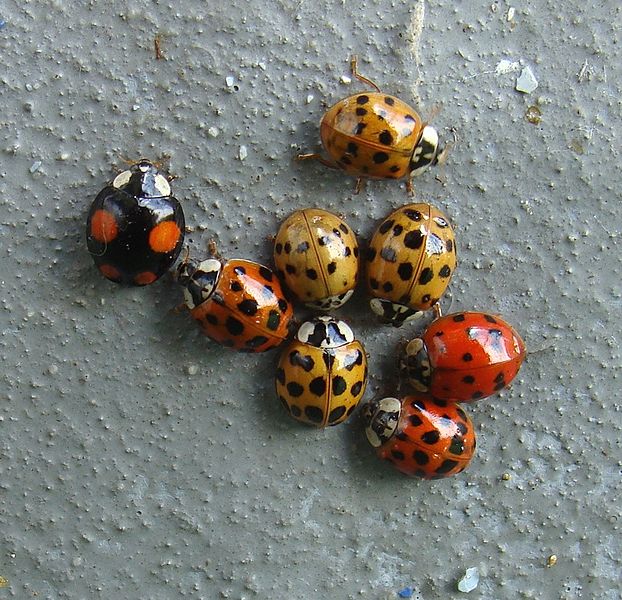All the posts are set, and our top wires have been installed!
All that we have left for trellis construction is the bottom wire and the twine for climbing. The hops are certainly ready for some vertical growth.
Friday, May 31, 2013
Thursday, May 30, 2013
Controlling pests with flowers
Many researchers, including us (and more specifically: Ben), have been studying ways to control pests by attracting natural enemies to crops. Ben has tested floral strips which he planted next to his pumpkin plots, and one of the flowers he tested was sweet alyssum. While Ben has been busy writing his thesis...a study came out of Washington State University that tested the effect of sweet alyssum placed next to orchards. They found a significant decrease in the number of aphids in plots with the flowers compared to plots without flowers. For more info check out the article: www.sciencedaily.com: Controlling aphids with flowers
Ben will be presenting his results soon, and we are excited to see if he had similar results!
Ben will be presenting his results soon, and we are excited to see if he had similar results!
Tuesday, May 21, 2013
Hops Update
We've made some good progress in our Wooster hops yard.
Most of the plants have leaves...
The construction of our trellis system has started as well!
Holes have been dug...
...and posts have been "planted".
Most of the plants have leaves...
...and some of the plants are just emerging now.
The construction of our trellis system has started as well!
Holes have been dug...
...and posts have been "planted".
Friday, May 17, 2013
Asian lady beetle + microsporidia = Native lady beetle death!
As we've noted before in this blog, the decline of many native lady beetle species occurring in North America and other countries coincides with the presence of the Asian lady beetle, Harmonia axyridis. The mechanisms as to why this is the case have been unclear. Is Harmonia a more effective predator than natives? Is it merely eating the natives at a particular life stage (termed intraguild predation, and the topic of Chelsea's M.S. thesis)? Does it have a faster life cycle and therefore able to reproduce in higher numbers?
A new study published today in Science reports that H. axyridis may be such an effective invasive species due to microsporidia in its hemolymph. These microsporidia are safe for their hosts, but when native species (to Europe), such as Coccinella septempunctata, were injected with these microsporidia they died. In the field, this may mean that consumption of H. axyridis eggs is lethal to intraguild competitors.
C. septempunctata is also established in the U.S., and is a dominant competitor of our own native species. It will be interesting to see how these new findings will influence our understanding of American native lady beetle declines.
Report in Science (paywall): http://www.sciencemag.org/content/340/6134/862
Science Daily article: http://www.sciencedaily.com/releases/2013/05/130516142541.htm
Are you signed up for the Gardiner Lab Buckeye Lady Beetle Blitz training workshop?
A new study published today in Science reports that H. axyridis may be such an effective invasive species due to microsporidia in its hemolymph. These microsporidia are safe for their hosts, but when native species (to Europe), such as Coccinella septempunctata, were injected with these microsporidia they died. In the field, this may mean that consumption of H. axyridis eggs is lethal to intraguild competitors.
C. septempunctata is also established in the U.S., and is a dominant competitor of our own native species. It will be interesting to see how these new findings will influence our understanding of American native lady beetle declines.
 |
| Harmonia axyridis (wikipedia) |
Science Daily article: http://www.sciencedaily.com/releases/2013/05/130516142541.htm
Are you signed up for the Gardiner Lab Buckeye Lady Beetle Blitz training workshop?
Wednesday, May 15, 2013
Monday, May 13, 2013
Hops update
The plants are starting to emerge!
...and the hops in the greenhouse are really starting to take off!
Thursday, May 9, 2013
Hops yard progress: Rhizome planting in Wooster
Step 1: Mark the plots clearly. Rhizomes of different varieties look similar, and the last thing you want to do is mix them up. A good start is knowing exactly which varieties will go where before you even take the rhizomes out of the cooler.
Step 2: If you use landscape fabric (for weed control), burn holes with a torch.
Step 3: Grab your (well organized and labeled) rhizomes!
Step 4: Start planting! We followed the methods demonstrated in this video:
Step 2: If you use landscape fabric (for weed control), burn holes with a torch.
Step 3: Grab your (well organized and labeled) rhizomes!
Step 4: Start planting! We followed the methods demonstrated in this video:
Step 5: Watering: Give them a generous amount of water. We gave each rhizome 1 liter, and also considered the fact that it was going to rain later in the day. Keep an eye on them; you should not let the soil dry out, but too much water can be detrimental for rhizomes you are trying to establish.
THANK YOU THANK YOU THANK YOU to the graduate students (Jake, Liz, and Doug) who volunteered their time to help us get the hop yard planted!
Now it's time for the waiting and watering game...many more updates to come!
Sunday, May 5, 2013
Trackin' Bumbles.
Subscribe to:
Posts (Atom)





























